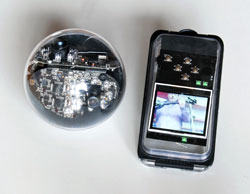The story of a camera, set free of its earthly restraint.
While experimenting in his Boston workshop, inventor Steve Hollinger made a startling discovery. His compact camera, when tossed into the air, captured seamless ribbons of imagery from an aerial viewpoint, rich in data to mine, analyze and assemble. Set free of the restraining grip of a photographer's hand or tripod, a camera could spin smoothly through a trajectory — one uniquely suited for capturing spectacular views of the world around it.
Experiments on Boston's Harbor Islands
 |
 |
 |
Early working prototype throwable wireless color video camera with multiple image sensors, wide FOV, 30 FPS near-zero latency. Camera and monitor are waterproof and buoyant.
|
Over the course of a year, Hollinger built elaborate rigs capable of hosting multiple cameras. Outdoor explorations on Boston's remote Harbor Islands revealed panoramic vistas and glimpses into inaccessible spaces, a battery of underground fortress rooms and tunnels.
Drawing from his findings, Hollinger filed three patent applications at the U.S. Patent and Trademark Office describing a wide array of throwable camera innovations.
In September 2009, Hollinger's panoramic
"Smart Spheres for Reconnaissance and Recreation" were unveiled in Boston's Seaport/Innovation District.
Low-cost IMU Technology and the Birth of Personal Drones
In years as recent as 2010, location and stabilization technology for personal drones had been the realm of hobbyists, a community driven by pioneers, among them Chris Anderson and the late Fabio Varesano. DIY drone prototypes were being guided by Sparkfun microelectronics, enriched by open hardware/software and shared among forum members at Anderson's DIYDrones.com. Many early adopters relied on Varesano's groundbreaking FreeIMU platform. This was the creative community within which Hollinger's prototyping of intelligent throwable devices evolved. During these few years, prototypes from the DIY community would move to commercialization. And not long thereafter, an entire drone/UAV/UAS industry would soar.
About Serveball Labs
Serveball Labs is the Boston-based imaging division of S. H. Pierce & Co., an award-winning manufacturer and licensor of high-technology products founded in 1989.
S. H. Pierce & Co. has developed a portfolio of brand name products, most recently launching Kayalu Gear. Kayalu Gear is a market-leading manufacturer of kayak and boating equipment including the top-selling Kayalite™ kayak navigation light (U.S. Patents #8,651,440, #8,814,111, patents pending).
In the technology arena, S. H. Pierce & Co.'s PosterWorks® large-format production software (U.S. Pat. #5,715,331) was the first professional large-format digital printing application available for desktop computers. Wrapping dynamic color graphics around billboards, buses, trains and entire buildings, PosterWorks and 35,000 licensed users worldwide established and defined the large-format digital printing space for over a decade.
Commercial imaging products developed by S. H. Pierce & Co. include RIPLink™ color pre-press and trapping software, FlipBook® video printing software, and a stop-motion image capture and printing system licensed to the American Museum of the Moving Image (Astoria, NY). Founder Steve Hollinger has served as contributing writer with a focus on image processing applications for Electronic Systems Design (ESD) magazine. A profile of Hollinger by author Susan Orlean (The Orchid Thief) was published in The New Yorker.
Serveball is focused on developing consumer and industrial imaging products that meet the demands of our customers. For further information please contact us.
|